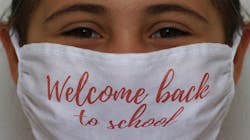CDC updates strategy for reopening schools
The Centers for Disease Control and Prevention (CDC) published an operational strategy that presents a pathway to reopen schools and help them remain open through consistent use of mitigation strategies, especially universal and correct use of masks and physical distancing, in order to have success in preventing the introduction and subsequent transmission of SARS-CoV-2, the virus that causes COVID-19, in schools and preventing transmission in the broader community.
It is critical for schools to open as safely and as soon as possible, and remain open, to achieve the benefits of in-person learning and key support services. To enable schools to open safely and remain open, it is important to adopt and consistently implement actions to slow the spread of SARS-CoV-2 both in schools and in the community. This means that all community members, students, families, teachers, and school staff should take actions to protect themselves and others where they live, work, learn, and play.
This operational strategy presents recommendations based on the best-available evidence at the time of release. As science and data on COVID-19 continue to evolve, guidance and recommendations will be updated to reflect new evidence. This document is intended to complement CDC’s guidance, tools, and resources for K-12 schools, including guidance on operating schools during COVID-19 and overview of testing for SARS-CoV-2 (COVID-19).
This document is intended to complement the U.S. Department of Education’s Handbook on Strategies for Safely Reopening Elementary and Secondary Schools. It reflects evidence on COVID-19 among children and adolescents and what is known about SARS-CoV-2 transmission in schools, summarized in CDC’s Science Brief on Transmission of SARS-CoV-2 in K-12 Schools.
Evidence suggests that many K-12 schools that have strictly implemented mitigation strategies have been able to safely open for in-person instruction and remain open. This document provides an operational strategy to support K-12 schools in opening for in-person instruction and remaining open through an integrated package of mitigation components. These essential elements include:
· Consistent implementation of layered mitigation strategies to reduce transmission of SARS-CoV-2 in schools
· Indicators of community transmission to reflect level of community risk
· Phased mitigation and learning modes based on levels of community transmission
The following public health efforts provide additional layers of COVID-19 prevention in schools:
· Testing to identify individuals with SARS-CoV-2 infection to limit transmission and outbreaks
· Vaccination for teachers and school staff, and in communities, as soon as supply allows
The absence of in-person educational options may disadvantage children from low-resourced communities, which may include large representation of racial and ethnic minority groups, English learners, and students with disabilities. Plans for safe delivery of in-person instruction in K-12 schools must consider efforts to promote fair access to healthy educational environments for students and staff. Thus, essential elements of school reopening plans should take into account the communities and groups that have been disproportionately affected by COVID-19 infections and severe outcomes. Schools play a critical role in promoting equity in education and health for groups disproportionately affected by COVID-19.
The strategy covers:
· Mitigation strategies to reduce transmission of SARS-CoV-2 in schools
· Indicators of community transmission
· Phased mitigation, learning modes, and testing
· Vaccination for teachers and staff, and in communities
